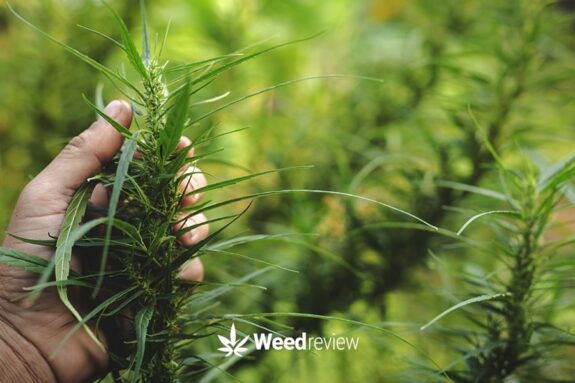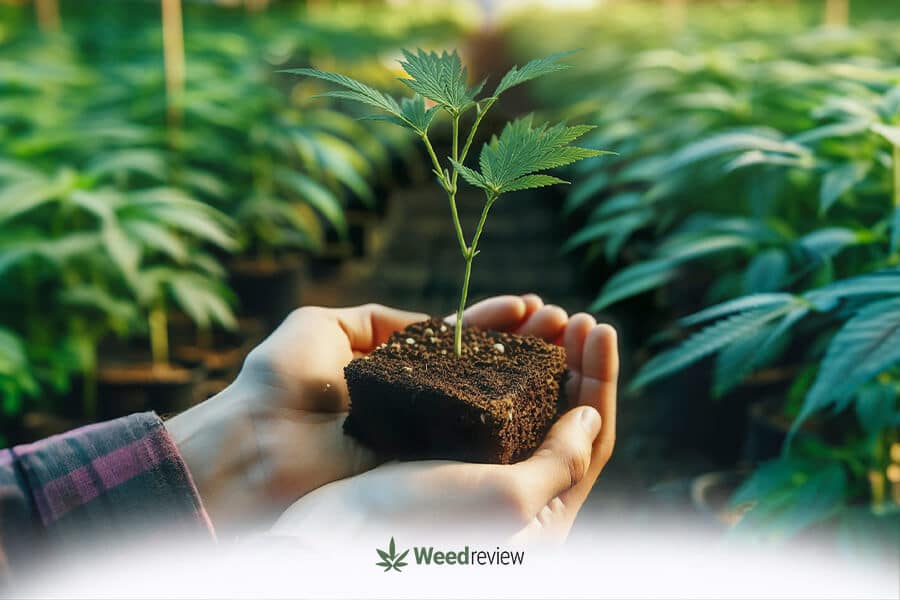
Cannabis Cloning Simplified: A Step-by-Step Guide to Growing Marijuana Cuttings

Table of Contents
Cloning is a practice that has become popular for its ability to produce consistent, high-quality marijuana plants.
For many growers, especially those just diving into growing their own cannabis, the process of cloning can seem difficult. This article is dedicated to making cannabis clones easy. We will look at what cannabis clones are, why mother plants matter, and how to go about making your own clones.
Whether you’re a seasoned grower or a curious newcomer, our journey through the art of cloning marijuana plants promises to equip you with the skills needed to produce exact replicas of your favourite strain – time and again.
What are cannabis clones?
Cannabis clones are cuttings taken from a mature female cannabis plant – known as the mother plant – which is then encouraged to root and grow into a new plant. These are the exact copies of the parent cannabis plant.
The cloning process, by replicating the genetic material of the mother plant, ensures each clone exhibits identical traits, from taste and effects to growth patterns and yield potential.
Unlike growing from seeds, where each seed has the potential to develop slightly differently due to genetic variations, clones offer predictability and control that can be crucial for growers.
For example, if you manage to grow a Jack Herer plant to your liking and want the same results again, you can take cuttings from this plant and grow them into new full plants. This ensures you get the same distinct characteristics, like its robust flavour, aromatic profile, and the specific effects that the original plant provided.
Benefits of cloning cannabis: Why choose clones?

Clones offer many advantages, making them popular among newcomers and experienced growers.
- Genetic consistency: Each clone is an exact genetic match to its mother plant. This means growers can expect uniform growth patterns, flavour, potency, and yield.
- Faster harvest: Clones skip the germination phase that seeds have to go through. They are the same age as the mother plant and are completely mature. This can shave weeks off the cultivation time, allowing for faster harvest cycles.
- Mass reproduction: One remarkable advantage of cloning is the ability to produce multiple new plants from a single mother plant. A healthy cannabis plant can provide dozens of clones, giving you a fresh batch of plants every couple of weeks.
- Big cloning window: Cloning isn’t restricted to just one phase of a plant’s life. While clones taken during the vegetative stage might root slightly faster, you can still take them in the flowering period – up to 2-3 weeks before harvest.
- Preservation of unique strains: If you stumble upon a particular plant with desired characteristics, cloning allows you to preserve those traits, ensuring you can reproduce the same quality repeatedly.
- More in less space: Given that you’re working with cuttings and not full-grown plants initially, clones allow you to maximise the grow space, especially during the early stages of the cultivation process.
- Cost-effective: Over time, cloning can be more economical than continually buying seeds, especially if you’ve found a strain you love and want to stick with it.
- Environmental benefits: Reusing a mother plant for multiple clones can lead to less wastage and a reduced need for purchasing new plants or seeds.
Marijuana clones vs. growing from seeds: Which is better?
When deciding between marijuana clones and growing from seeds, you’re essentially choosing between consistency and diversity.
| Aspect | Marijuana Clones | Growing from Seeds |
|---|---|---|
| Time Efficiency | No males if the mother is a female | No males if the mother is female |
| Genetic Consistency | Faster growth skips germination | Genetic variation in each seed |
| Space Requirement | Less space needed | More space for germinating seeds |
| Cost Effectiveness | Generally lower cost | Can be more expensive |
| Risk of Male Plants | Identical to the mother plant | Potential for male plants |
Clones are a genetically identical photocopy of the plant, whereas seeds are like siblings – similar, but each with unique characteristics.
Clones offer genetic consistency, mirroring the traits of the parent plant. This means you can expect uniform flavour, potency, and growth results. They do not undergo the germination phase – instead, they start with a stem and develop the vegetative phase.
This leads to quicker growth and faster harvests. They’re reliable for those seeking a consistent outcome – suitable for commercial or medicinal purposes.
On the other hand, growing from marijuana seeds brings genetic diversity to the table. Each seed carries a unique genetic makeup, resulting in strains of varying terpene and cannabinoid profiles. Seed-grown plants also develop strong taproots and have a lower risk of inheriting pests or diseases.
Many experienced growers use a mix of both methods.
What are cannabis mother plants?
Cannabis mother plants are specially chosen, healthy cannabis crops grown explicitly for producing cuttings or clones. These mother plants are essential in the cloning process as they provide the genetic blueprint for the clones. Clones taken from a female plant will all be female and mirror the mother plant, except for minor phenotype variations, which is just nature’s course.
Mother plants are always kept in the vegetative stage (18-6 light cycle); the flowering phase is not triggered. Taking cuttings from a cannabis plant that is in its flowering stage can lead to the risk of the clone developing hermaphroditic traits. Additionally, this practice could potentially harm the health and development of the flowering plant itself.
Many growers have dedicated mother plants to maintain a steady supply of clones; in practice, this takes effort and time since the plant health needs to be maintained and kept perpetually in the vegetative phase.
When these clones are grown in identical conditions, they typically display a uniform appearance. However, if the same set of clones is cultivated in different environments or separate garden rooms, they often exhibit noticeable differences in their appearance due to the varying growing conditions.
How to choose mother plants
Growers opt for marijuana mother plants grown from regular seeds or F1 hybrids (first-generation cross of two parents) rather than feminised or autoflowering. This preference is due to the stability and reliability of regular seeds. Regular seeds produce plants that, under normal conditions, are less likely to develop hermaphroditic traits, especially under the stress of prolonged vegetative growth and frequent cloning.

Feminised seeds, while convenient for ensuring female plants, may have a heightened risk of hermaphroditism when subjected to the regular pruning and cuttings associated with mother plants. Autoflowering seeds are generally not used because they cannot be kept in the vegetative stage indefinitely, which is crucial for a mother plant to continuously provide clones.
Selecting the right mother plant also involves looking at:
- Genetic quality: Use regular seeds for selecting mother plants, as they are less likely to produce hermaphroditic traits under stress. F1 hybrids, the first generation of a cross between two parent strains, are often preferred due to their strong genetics.
- Health and vigour: Choose plants with strong, robust growth; a vigorous mother plant can produce cuttings for years.
- Resistance to pests and diseases: The mother plant should be resilient against common pathogens.
- Healthy roots: Opt for plants with a well-developed root system, indicating quicker maturity.
- Desirable traits: Pay attention to the plant’s yield, aroma, and physical characteristics like size, internodal spacing, and colour. You want plants which are healthy and have the potential to produce big buds.
- Flowering time: Consider how quickly the plant reaches the flowering stage.
How to make cannabis clones?
Remember that the stem that once grew leaves now needs to grow roots; they are at the most fragile stage of their life and require utmost care.
This involves choosing the right parts of the mother plant and understanding the optimal conditions for cloning.
Materials needed
Here is what you need:

- Healthy mother plant
- Sharp, sterilised scissors or razors
- Rooting hormone
- Starter cubes or soil
- Clear plastic dome or cling film
- Grow tray
- Spray bottle
- Grow lights
Note: Experienced growers and commercial farmers can invest in cloner devices – known as auto-cloners – designed specifically to harvest clones.
How to choose the cuttings from the mother plant?
Ideal cuttings should have the following:
- Healthy and robust branches, ideally 5-6 inches long.
- At least two nodes, as these are key points for root development.
- Thin stems as thick ones are filled with starch and can take time to grow.

When to take the cuttings from the mother plant?
The best time to take cuttings is right after the pre-flowering phase when the plant has expressed its sex. In addition, keep the following in mind:
- Ensure the plant is at least two months old and hasn’t been fertilised for at least a week.
- Avoid taking cuttings before the plant shows pre-flowers, as this can lead to male or intersex plants.
- Clones taken during the flowering phase may take longer to revert to vegetative growth and can encounter growth issues.
How to take the cutting?
Cloning, at its core, is a straightforward process, but attention to detail can make all the difference. Here’s a step-by-step overview to guide you.


- Leach the growing medium of the mother plant with water every morning for a week. This helps wash out excess nitrogen, which can interfere with cloning. Ensure good drainage and avoid fertilising during this leaching process.
- Sterilise all tools and workspace, and wear gloves to maintain a sterile environment.
- Select a branch just under the lowest node and make a 45-degree cut to maximize the surface area for root growth. Immediately place the cuttings in pH-corrected water to prevent air pocket formation.
- Remove lower leaves and trim the tips of the topmost leaves to focus the plant’s energy towards root development. Excess leaves mean the plant has to focus on photosynthesis when it should focus on growing roots.
- Apply rooting hormone, available in powder, liquid, or gel forms, to the end of the cutting. Take care not to apply the hormone on the leaves.
- Place the clones in the prepared medium, such as soaked rockwool cubes, rooting cubes, or peat pellets. Avoid soil as it is loose and does not provide the much-needed stability to new clones. The growing medium should be put in a grow tray to support the delicate clones.
- Keep an acidic pH of 5.5-6.5 in the growing medium; do not overfertilise.
- Maintain a warm, humid environment, especially in the first 48 hours. Keep the cuttings moist at all times but don’t let them get soggy. Use a humidity dome and heating pad if available, and keep the temperature between 23-27°C. Use low-intensity fluorescent lights from far away – at least 7-10 inches – and keep them on for 18-19 hours daily.
How to clone cannabis in hydroponics?
Cloning cannabis in hydroponics follows a similar initial process to what we saw above. After selecting a healthy mother plant and taking your cuttings, the key differences come in the medium and system you use:
- Rooting in hydroponic medium: Place the cuttings in a hydroponic-friendly medium such as Rockwool cubes. This step is critical as Rockwool cubes provide the necessary support and moisture retention for the clones.
- Transferring to the hydroponic system: Once the clones develop roots, transfer them into your hydroponic system.
- Environmental control: In hydroponics, careful monitoring and adjustment of nutrient solutions, pH levels, and water temperature are crucial for the clones’ development.
This method leverages the benefits of hydroponics, such as potentially faster growth and reduced pest issues, for successful cannabis cloning.
How long does it take for clones to grow?
Your clones can take 1-3 weeks to build a healthy root system and become ready to grow further. Common signs that clones are ready to be transplanted into a bigger medium are:
- Yellowing at the leaf tips.
- Roots emerging from drainage holes.
- Clones beginning to grow upwards.
- Roots are starting to outgrow the growing medium.
What to do when your clones are wilting?
Wilting occurs when plants struggle to take water from roots. This is common among clones where new roots are still forming, which means the plants get their water from the leaves or the cut stem.
It is natural for some clones to wilt initially but get back in shape after a few days as they start getting water. So if you see your clones wilting, wait for before disturbing their delicate setting. Cuttings which are still wilted after a 6-7 days of planting may never grow successfully and may be prone to diseases and pests. They should be discarded immediately.
Apart from this, you can maintain the optimal conditions to prevent wilting:
- Ensure the medium is moist but not waterlogged.
- Excessive light or heat can stress clones. Adjust the distance or intensity of lights.
- Maintain high humidity around clones, as low humidity can lead to wilting.
How do you transplant clones?
Once the clones have developed a modest root system, they can be transplanted. Here’s a short overview:
- Prepare the new medium: Before transplanting, prepare the pots with your chosen soil or hydroponic medium.
- Gentle removal: Carefully remove each clone from its current medium, ensuring no damage to the fragile root system.
- Placement: Place the clone in the new medium, making sure the roots are adequately covered and the plant is stable.
- Watering: Water the clones immediately after transplanting to help ease the transition and reduce transplant shock.
- Environment: If you’re moving clones from a high-humidity dome or environment to an area with lower humidity, gradually have them adapt to the surroundings. This can be done by slowly increasing their exposure to the new environment over several days.
- Monitor and adjust: After transplanting, monitor the clones closely for signs of stress and adjust care as necessary, including light, water, and nutrients.
By following these steps, you can help your clones adapt smoothly to their new growing environment, setting them up for robust growth.
Conclusion & next steps
As we conclude our journey through cloning cannabis, remember that success in cloning is just the beginning.
Your focus now shifts to the vegetative phase of your clones’ growth. It’s essential to maintain an optimal environment – carefully managing light, nutrients, and water – to ensure healthy vegetative growth. Regularly monitor your plants for signs of health and vigor, adjusting care as needed.
As your clones develop, consider experimenting with different training techniques to maximise yield. You can even try germinating your own seeds from scratch to see the uniqueness of each method. Stay curious, keep learning, and use each cloning cycle as an opportunity to refine your cultivation skills.


